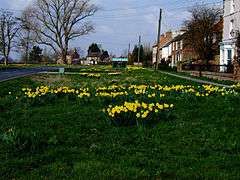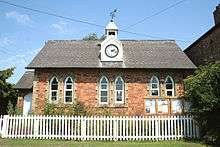Flaxton, North Yorkshire
Flaxton is a small village and civil parish in the Ryedale district of North Yorkshire, England. It is close to the A64 between York and Malton. The village lies entirely within a Conservation Area as defined by Planning (Listed Building and Conservation Areas Act) 1990.[2]
| Flaxton | |
|---|---|
 Rice Lane, Flaxton | |
 Flaxton Location within North Yorkshire | |
| Population | 343 (2011 census)[1] |
| OS grid reference | SE678623 |
| Civil parish |
|
| District | |
| Shire county | |
| Region | |
| Country | England |
| Sovereign state | United Kingdom |
| Post town | YORK |
| Postcode district | YO60 |
| Police | North Yorkshire |
| Fire | North Yorkshire |
| Ambulance | Yorkshire |
| UK Parliament |
|
History
The village is mentioned in the Domesday Book as Flaxtune in the Bulford hundred. At that time it was part of the manor of Foston and was in the possession of Earl Morcar, but passed to Count Alan of Brittany by 1086.[3] The etymology of the name is taken from Old English meaning settlement where flax is made.[4]
In 1807 a lead box containing around 300 Saxon silver coins was discovered in a field near the village.[5]
Flaxton was served by Flaxton railway station on the York to Scarborough Line between 1845 and 1930.[6]
Governance
The village lies within the Thirsk and Malton (UK Parliament constituency). It is also within the Hovingham & Sheriff Hutton electoral division of North Yorkshire County Council and the Sheriff Hutton ward of Ryedale District Council.[7]
Geography
The nearest settlements to the village are Claxton 1.5 miles (2.4 km) to the south; West Lilling 2.2 miles (3.5 km) to the north-west; Harton 1.5 miles (2.4 km) to the east and Thornton-le-Clay 1.6 miles (2.6 km) to the north-east.[7]
The 1881 UK Census recorded the population as 366.[8] According to the 2001 UK Census, the village had a population of 331, of which 255 were over the age of sixteen. Of these, 168 were in employment. There were 138 dwellings, of which 86 were detached.[9] The 2011 Census showed a population of 343.[1]
The village areas around Flaxton Village Green and the Crofts are designated Sites of Importance for Nature Conservation (SINCs). Here can be found semi-improved and unimproved neutral grassland, as well as wet grassland on the Keld with three ponds that include two great crested newt breeding sites.[4]
It has one pub, the Thompson Arms Inn, and a B&B, the Blacksmiths Arms.
Education

In 1867 a Church of England school was built in the village. It was built by Thomas Abbey of Claxton on land donated by Thomas Richard Smith and paid for with money raised by the Rector and parishioners. The clock is by Potts of Leeds and dates to the end of the 19th-century.[10]
The school closed in 1987 and was listed as a Grade II building in 2011 as an unusual surviving example of school for poorer children which pre-dates the 1870 Education Act.[10]
The village is now within the education catchment areas of Sand Hutton primary school[11] and Huntington School, York.[12]
Religion
.jpg)
The village has a church dedicated to St Lawrence, which was built in 1853 in the 13th-century Gothic style and replaced an earlier chapel.[8][13][14] The church was declared a rectory in 1867 before which time it had been a perpetual curacy.[13][15]
The lychgate was erected as a memorial after the First World War.[16]
References
- UK Census (2011). "Local Area Report – Flaxton Parish (1170217237)". Nomis. Office for National Statistics. Retrieved 17 March 2018.
- "Conservation Area". Archived from the original on 22 September 2013. Retrieved 22 December 2012.
- Flaxton in the Domesday Book. Retrieved 22 December 2012.
- "Etymology" (PDF). Archived from the original (PDF) on 19 November 2012. Retrieved 22 December 2012.
- Baines, Edward, ed. (1823). History, Directory & Gazeteer, of the County of York: Vol. II East and North Ridings. p. 440. Retrieved 17 April 2020.
- Butt, R. V. J. (1995). The Directory of Railway Stations: details every public and private passenger station, halt, platform and stopping place, past and present (1st ed.). Sparkford: Patrick Stephens Ltd. ISBN 978-1-85260-508-7. OCLC 60251199.
- "OpenData Viewer". Ordnance Survey. Archived from the original on 5 October 2012. Retrieved 14 October 2012.
- Bulmer's Topography, History and Directory (Private and Commercial) of North Yorkshire 1890. S&N Publishing. 1890. p. 705. ISBN 1-86150-299-0.
- "2001 UK Census". Neighbourhood Statistics. Office for National Statistics. Retrieved 22 December 2012.
- Historic England. "Flaxton Old School (1406423)". National Heritage List for England. Retrieved 17 April 2020.
- "Map: primary school catchment areas". North Yorkshire County Council. Retrieved 17 April 2020.
- "Guide to School Catchment Areas". City of York Council. p. 53. Retrieved 17 April 2020.
- Page, William (ed.). "Parishes:Bossall". A History of the County of York North Riding: Volume 2. London. pp. 91–98. Retrieved 17 April 2020 – via British History Online.
- "Parish Records for Flaxton: Finding Aid" (PDF). Borthwick Institute / University of York. Retrieved 17 April 2020.
- "No. 23288". The London Gazette. 6 August 1867. p. 4368.
- "St Lawrences Lych Gate - WWI". Imperial War Museum. Retrieved 17 April 2020.
External links
| Wikimedia Commons has media related to Flaxton, North Yorkshire. |